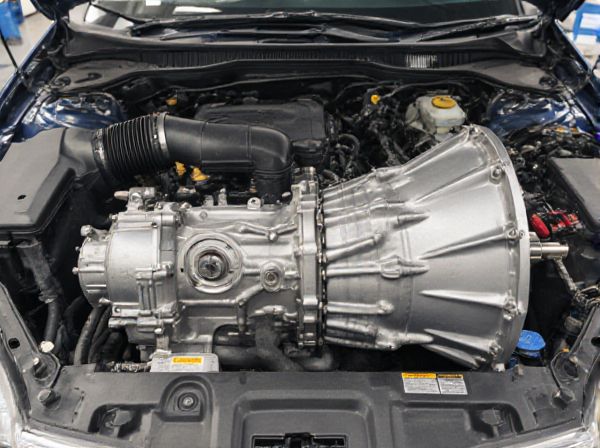
Photo illustration: Dog Box Transmission vs Synchromesh Transmission
Dog box transmission offers faster, more direct gear shifts often preferred in high-performance or racing vehicles, while synchromesh transmission provides smoother, more user-friendly gear changes ideal for everyday driving comfort. You benefit from the dog box's quick engagement and durability during aggressive driving but might sacrifice some ease of use compared to the synchromesh's synchronized gear coordination. Choosing between them depends on your driving needs, balancing speed and precision against smoothness and accessibility.
Table of Comparison
| Feature | Dog Box Transmission | Synchromesh Transmission |
|---|---|---|
| Shift Mechanism | Dog gears engage instantly without synchronization | Synchronizers match gear speeds for smooth shifts |
| Shift Speed | Extremely fast shifting, ideal for racing | Moderate shifting speed, designed for comfort |
| Durability | High durability under high stress and racing conditions | Good durability for everyday driving |
| Shift Effort | Requires precise timing and skill | Smoother shifts with less driver effort |
| Application | Motorsport, racing vehicles | Passenger cars, commercial vehicles |
| Noise Level | Higher noise due to direct engagement | Quieter operation with synchronizers |
| Maintenance | Requires frequent maintenance in racing conditions | Lower maintenance for everyday use |
Introduction to Transmission Systems
Dog box transmissions employ dog clutches for rapid, direct gear engagement, enhancing performance in motorsports by minimizing shift time and power loss. Synchromesh transmissions use synchronizers to match gear speeds before engagement, ensuring smooth and quiet shifts ideal for everyday driving comfort. Both systems fundamentally transmit engine power to the drivetrain but differ significantly in shifting mechanisms and intended applications.
What is a Dog Box Transmission?
A Dog Box Transmission utilizes dog clutches instead of synchromesh mechanisms to engage gears, enabling faster and more direct gear shifts ideal for racing applications. Unlike Synchromesh Transmissions, which use synchronizers to match gear speeds and ensure smooth shifting, Dog Box Transmissions eliminate shift delays by locking directly into gear positions. This results in increased durability and reduced shift times but requires precise driver timing to avoid gear grinding.
How Synchromesh Transmission Works
Synchromesh transmission operates by using synchronizer rings to match the speed of the gears before engagement, ensuring smooth shifting without grinding. These rings use friction to equalize the rotational speeds of the input and output shafts, allowing seamless gear changes. This mechanism improves drivability and reduces wear compared to dog box transmissions, which require precise timing to engage gears.
Key Differences Between Dog Box and Synchromesh Transmissions
Dog box transmissions use dog clutches to engage gears directly without synchronizers, allowing for faster gear shifts and reduced drivetrain slugging, ideal for racing and high-performance applications. Synchromesh transmissions rely on synchronizer rings to match gear speeds before engagement, providing smoother and quieter shifting, making them suitable for everyday driving. Key differences include the presence of synchronizers, shift smoothness, durability under high stress, and overall driving experience.
Performance Comparison: Dog Box vs Synchromesh
Dog box transmissions offer faster, more precise gear shifts with minimal power interruption, making them ideal for high-performance and racing applications. Synchromesh transmissions prioritize smoothness and ease of shifting, using synchronizers to match gear speeds, but this can result in slower shift times and increased drivetrain losses. Performance-wise, dog boxes excel in durability under aggressive shifting conditions, while synchromesh units favor driver comfort and everyday usability.
Durability and Maintenance Considerations
Dog box transmissions offer superior durability due to their robust, gear-driven design that endures high torque and aggressive shifting without clutch use, making them ideal for racing applications. Synchromesh transmissions, equipped with synchronizer rings, provide smoother shifts and are easier to maintain in daily driving conditions but tend to experience more wear over time due to synchronizer and clutch component friction. Maintenance for dog box transmissions is less frequent but requires specialized knowledge, while synchromesh gearboxes demand regular clutch adjustments and synchro replacements to sustain optimal performance.
Advantages of Dog Box Transmissions
Dog Box transmissions offer faster and more precise gear shifts due to their direct engagement mechanism, reducing shift times significantly compared to synchromesh transmissions. They provide greater durability and can handle higher torque loads, making them ideal for racing and high-performance vehicles. The simplified design of dog box transmissions minimizes the risk of gear grinding, enhancing reliability in aggressive driving conditions.
Benefits of Synchromesh Transmissions
Synchromesh transmissions provide smoother gear shifts by synchronizing gear speeds before engagement, reducing wear and driver effort compared to dog box transmissions. They enhance drivability and comfort, especially in everyday driving conditions where frequent shifting is required. These transmissions also minimize gear clash noise, making them ideal for street use and long-distance travel.
Suitability for Racing and Street Use
Dog box transmissions offer rapid, non-synchronized gear shifts ideal for racing, providing minimal shift times and greater durability under high-stress conditions. Synchromesh transmissions prioritize smooth engagement and ease of use, making them better suited for everyday street driving with quieter operation and reduced wear. While dog box transmissions excel in competitive environments requiring quick shifting, synchromesh remains preferred for driver comfort and conventional road use.
Which Transmission is Best for You?
Dog box transmissions offer faster, more precise gear shifts ideal for racing enthusiasts seeking performance and durability under high stress. Synchromesh transmissions provide smoother, quieter shifts suited for everyday driving comfort and ease of use without gear clash. Your choice depends on whether you prioritize aggressive driving performance or reliable, user-friendly operation for daily use.
 caratoz.com
caratoz.com